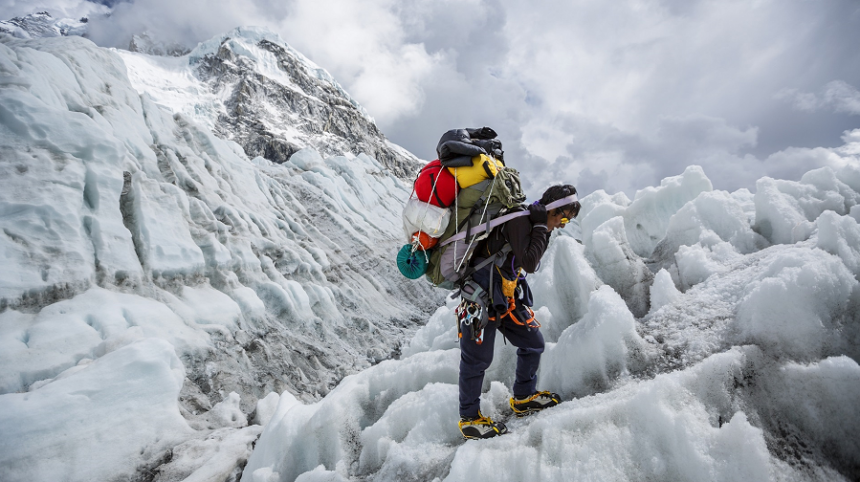In The Twilight Zone—(Sherpas): The High Stakes Industry Of Himalayas

By Colonel Satish Singh Lalotra
“Life’s a bit like mountaineering –Never look down” —Edmund Hillary
Who can forget the weekend scuffle between a group of sherpas and a small band of western climbers high on Mt Everest, roughly more than a decade in 2013 back throwing the all too important question of Sherpas and their social contact cum etiquettes to the world at large? The term ‘Sherpa’ was catapulted into world’s thinking horizon when on 29th May 1953 ‘Tenzing Norgay was one of the first two people to stand on the world’s highest point along with Sir Edmund Hillary as part of the now famous John Hunt’s mountaineering expedition. Although the term ‘Sherpa ‘ has long been in the lexicon of climbers and those associated with mountaineering , the general public as such is still ignorant to a large extent about the role being played by them in Himalayan climbing.
The scuffle that happened at camp -2 on way to Mt Everest may have been an outside manifestation of years of professional jealousy between the Sherpas and the western climbers that was splashed all over the national dailies of Nepal spanning from Kathmandu to Pokhra to Mustang, the high altitude region of this Hindu kingdom jutting into the Tibetan autonomous region. The Sherpas are a small ethnic group that share many cultural, racial and linguistic features with Tibetans, who live to their immediate north. For an uninitiated, it is very difficult to separate the two communities of Sherpas& the Tibetans for each overlap into other’s domain as explained above.
About 3000 Sherpas reside in the drainage areas immediately below Mt Everest; a population of more than 40000 or more live in the villages to the south. Until the early 1950s, no high Himalayan peak in Nepal had ever been climbed –at least by the mortals, the sherpas say. Then, as now, they saw the Himalayan peaks and foothills as the realm of a cavorting pantheon of Gods. Presciently, a prominent Sherpa Buddhist lama predicted many years ago that much attention would come to be focused on Mt Everest and that people would ‘suffer hardships as a result of negative deeds generated in her vicinity.
My sole aim of writing this article has been the interest in these Sherpas who draw a close and symbiotic relationship with their immediate northern neighbors i.e. the Tibetans with whom I served in the Special frontier force ( SFF) closely watching their habits & habitats that has an overarching bearing on the former’s lifestyle. Both of these closely knit communities of the northern highland abutting our national frontiers are guided in their everyday life by their spiritual leaders also called as the ‘Buddhist lamas’. These lamas by their omnipresence amongst the two different types of communities have been able to bridge as well as forge an undeniable link between climbing the peaks and maintaining the fine balance of motivation which is the so called ‘Sine quo non’ for this highly demanding and risk entitled profession of the world.
The Buddhist Lamas, the spiritual leaders of this Sherpa community say that one’s motivation in climbing Mt Everest and the nearby peaks is of key importance. Foreign climbers, when asked why they climb mountains offer a range of responses; testing one’s limits, personal achievement, companionship in a shared challenge, fun, spiritual understanding as well as wanting to improve one’s CV. I mean the range of responses is simply stupendous. In contrast when it comes to the Sherpas, the response is as straightforward as they are in their very being. Mountaineering for the Sherpas is the proverbial ‘Deliverance from poverty’, a high stakes game with the highest stake being offered in this game as their own life itself. Have we heard anywhere in the globe a high stakes game where your life itself is at stake to come on top of this game?
The success of Tenzing and Hillary inspired countless other climbers and trekkers to head to Nepal, spawning an industry that today provides work for 15,000 Sherpas as guides, porters, Sardars ( team leaders) and route setters delivering more than 600 climbers to the summit of Mt Everest year after year. High altitude climbing on the Himalayas would not be possible without the help of the Sherpas. Sherpas do all the heavy lifting, carrying tents, oxygen cylinders, supplies as also prepare the food not to forget matching step by step and even going ahead of the acclaimed climbers as route setters. They are naturally suited to work on Mt Everest and all the famed ‘8 Thousanders’ of the Himalayas. They are fit and resilient, know the weather conditions and the terrain, have a spiritual connection to the Himalayas and are physiologically adapted to dealing with the low effects of oxygen at high altitudes. Something I personally witnessed at the famed Siachen glacier way back in the early 1990s while serving with the Tibetan troops who too are blessed with larger than required lungs and used to race on the Soltoro ridge with gay abandon oblivious to the Pakistani bombardment or the looming / lurking avalanches.
A generation of these Sherpas found a route out of poverty by joining the international climbing expeditions of the 1950s and 1960s –including the famous ‘Nawang Gombu sherpa’ who in 1965 became the first person to climb Mt Everest twice. But this work comes with its attendant risks. The first recorded deaths of sherpas on Mt Everest were 7 sherpa porters lost in an avalanche during the failed British expedition of 1922. Since then, 125 sherpas have perished on the world’s highest mountain. While newspapers trumpeted the achievements of foreign climbers –the first ascent by a woman, Junko Tabei in 1975; the first ascent without oxygen, Reinhold Messener and Peter Habler in 1978 –hundreds of sherpas continued to climb the various 8 thousanders without much fanfare year after year. Earning a footnote in the world press, in 1988 Sungadre Sherpa became the first person to summit Mt Everest five times.
In 1996, Ang Rita Sherpa –nicknamed the ‘Snow leopard’ by his peers became the first person to summit 10 times the highest peak. Sherpas are incredibly humble people who don’t look for the limelight. But there was also a throwback to the colonial attitudes when these sherpas were not treated as equals on the famous John Hunt expedition of 1953. It would be very curious for the readers of this article to know that the same colonial mindset was visible even during the mid and late 19th century when the ‘Great Trigonometric society’ of India’ the precursor of ‘Survey of India’ employed hundreds of these sherpas and Tibetan porters on the icy heights of the mighty Karakorums and the Hindukush ranges for mapping and surveying these unknown peaks. Without these sherpas and Tibetan porters, famous George Everest wouldn’t have been able to crown himself with glory of naming Mt Everest after his name, though the glory belonged to an Indian surveyor Radha nath sikdar.
As per Lakpa Tsheri Sherpa who paraglided from top of Mt Everest in 2011, the greatest feat of rescue by a Sherpa climber was attempted with a resounding success when 2 team members of ‘Norit-K2 ‘team in August 2008 were rescued during one of the most devastating disasters in the mountaineering history by ‘Pemba Gyalje Sherpa. More recently various videos show the sheer dance of death that these sherpas play in order to rescue the lives on these various 8 thousanders. As far as the women sherpas are concerned they too have earned their slice of glory under the sun with the sheer dint of single –mindedness and resolute action towards attaining their goal.
On 22 April 1993, Pasang Lhamu Sherpa became the first Nepali woman to summit Mt Everest. She died tragically while descending, but her courage inspired many a new generations to take up the ice axes and fix crampons to their mountaineering shoes and head for the mountains. Dozens of Sherpa women are now playing key roles in the so called ‘Mountaineering industry’. Women like Dawa Yangzom, Maya Sherpa, and Pasang Lhamu have climbed most of the 8 thousanders. On May 2022, Makalu –born climber Lhapka Sherpa reached the summit of Mt Everest for the 10th time, the record for any female climber. Another leap forward came in 2019 , when ‘Nirmal Nimsdai Purja –a former Gurkha soldier from Dhulagiri completed the fastest ascent of all the fourteen 8 thousanders .
With all this halo surrounding this brave and never say die attitude amongst the sherpas, what exactly is the future of Sherpa climbing? Firstly with all the media hype and glare swooping down on this hapless community, it has become very easy for them to garner financial support from all over the world for funding their mountaineering expeditions. Ultimately the people around the globe hear amazing stories of these brave sherpas and open up their purse strings without batting an eyelid. However practical issues remain as a thorn on the sides of these sherpas. After the 2014 disaster, the Nepali authorities increased the mandatory life insurance that the expeditions are required to take out for local staff , but the payout of 1.5 million rupees ( around 9000 pound/sterling) if a Sherpa dies is only enough to support their dependents for one or two years.
Families increasingly rely on money donated by mountaineering expeditions / organizations such as the ‘Nepal mountaineering association& adventure consultants’ (NMAAC) Sherpa future fund established after the 2014 icefall disaster. With growing awareness and risk profiling done of this very dare devilry act of mountaineering, young sherpas are abandoning the mountains for safer work elsewhere. Many sherpas climb because there is no better alternative to earn the same amount of money. Depending upon their role and experience, sherpas can earn up to 4,000 pounds for a 2 months climbing expedition — more than a Himalayan subsistence farmer earns in a year. One only has to watch the Netflix movie starring famous climber cum soldier Nirmal Pujra in the movie ‘14 Peaks—nothing is impossible’ as to what was the home condition of the protagonist.
All in all, without adequate incentives coming its way this brave community of sherpas and its existence is in the twilight zone where anything and everything can happen. Need is to swing the pendulum of benevolence in its direction before the community is herded into the pages of oblivion. As has been famously said by Sir Hillary—‘LIFE IS BIT LIKE MOUNTAINEERING, NEVER LOOK DOWN’.
(The writer is a regular scribe of Rising Kashmir and can be contacted on his email: slalotra4729@gmail.com)




